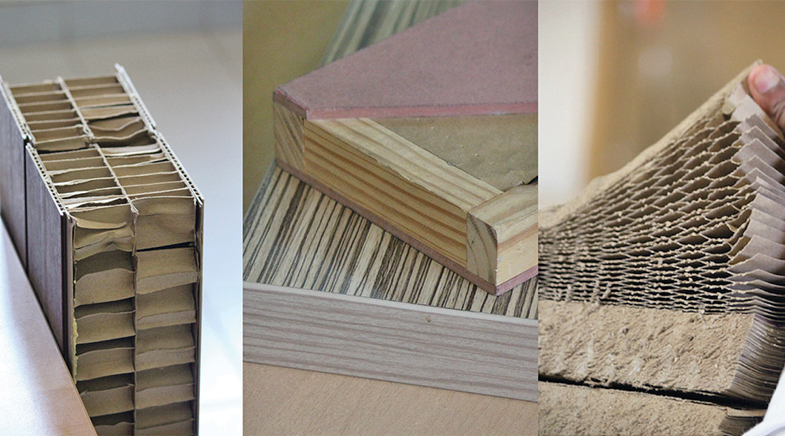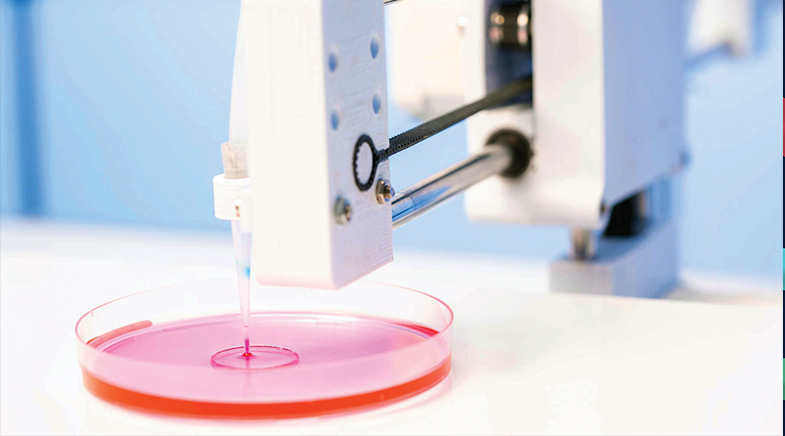Red alert!
-
- from Shaastra :: vol 04 issue 09 :: Oct 2025

Are the 'leopard spots' on Mars signs of ancient life? Time will tell.
The Jezero Crater on Mars was once home to a delta filled with water. But it ran dry billions of years ago, and all that remains now is a debris of rocks and dust. In February 2021, the Perseverance rover — a car-sized, six-wheeled vehicle fuelled by nuclear power — landed on this crater to search for signs of ancient life. In 2024, the National Aeronautics and Space Administration (NASA) rover found tiny, bleached spots scattered on red Martian rock in what's called the Bright Angel region of the crater. These millimetre-sized spots, named leopard spots, are surrounded by a thin, dark layer.
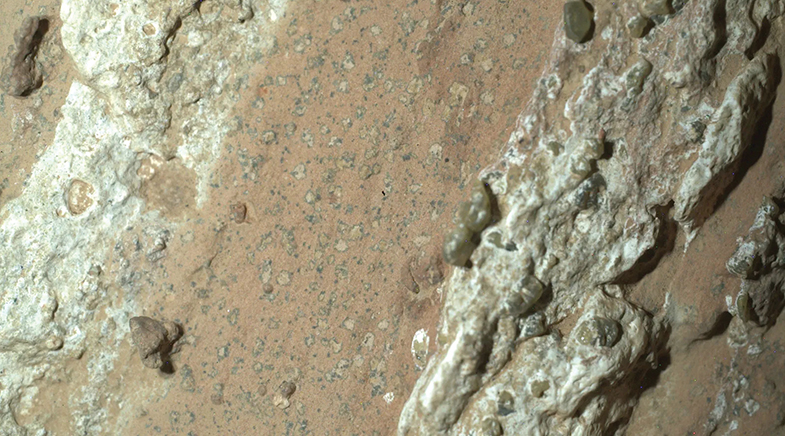
Now, nearly a year later, a study published in Nature in September 2025 (bit.ly/jezero-mars) states that the leopard spots may be potential biosignatures, an imprint of ancient life left on Martian rocks. The landing site for Perseverance was chosen after a five-year-long search, in which over 60 candidate locations were examined in detail. The researchers chose Jezero because of the possibility of locating traces of ancient microbial life there. On the mission's 1212th Martian day, the rover took pictures of rocks in the Bright Angel region with a camera called WATSON (Wide Angle Topographic Sensor for Operations and eNgineering), part of the SHERLOC (Scanning Habitable Environments with Raman and Luminescence for Organics and Chemicals) instrument suite aboard the rover (bit.ly/Leopard-Spots).
RICH IN MINERALS
A detailed examination of the spots revealed that they were rich in two iron-based minerals — vivianite (iron phosphate) and greigite (iron sulphide). On Earth, these minerals are associated with microbial life. The researchers state in the Nature paper that it is possible the Martian leopard spots were formed through a biological process involving a set of redox reactions that drove Fe (iron) and S (sulphur) reduction, organic matter oxidation, and the precipitation of Fe2+-phosphate and Fe-sulphide minerals. Redox reactions are common in the living world —transferring electrons from one type of chemical to another and generating energy in the process.
The 'leopard spots' on the Jezero Crater, rich in iron-based minerals, are potential biosignatures, an imprint of ancient life left on Martian rocks.
Evaluating the possibility of a non-biological origin of leopard spots, the researchers note that such spots could only have formed in high-temperature conditions, which the Bright Angel rocks were not exposed to. The current study does not prove beyond doubt that the minerals in question are of biological origin. But it does provide evidence that the minerals were formed as a result of chemical reactions that might have been driven by biological processes in an environmental setting known to be habitable to microorganisms on Earth, points out Joel Hurowitz, lead author of the paper and an Associate Professor in the Department of Geosciences, Stony Brook University, U.S. "This is not enough to prove that the minerals are formed by the activity of life, but it takes us one step closer in our evaluation of the possibility," he tells Shaastra.
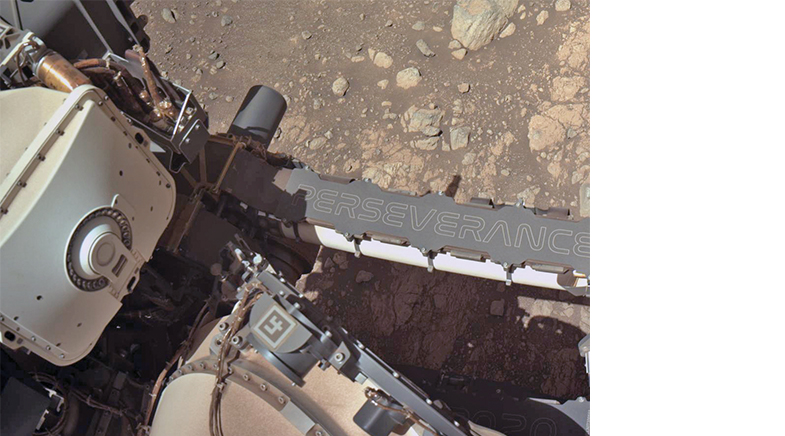
Sudha Rajamani, Professor of Biology at the Indian Institute of Science Education and Research (IISER) Pune, describes the results as "exciting". The Mars Sample Return (MSR) mission is "super-crucial", she says, as bringing the samples back to Earth "will allow us to ask multiple questions systematically and will change how confident we feel" about the biosignatures.
To study processes that may have shaped life on other planets, researchers look for conditions on Earth that somewhat mimic those in space.
The MSR mission, a collaboration between NASA and the European Space Agency, seeks to bring back Perseverance's rock collection to Earth. There is little clarity, however, on the timeline of this mission. Earlier this year, NASA invited industry proposals for a low-cost plan to return the samples — potentially sometime in the 2030s. China is also working on a Mars sample return mission. Called Tianwen-3, it is scheduled to be launched in 2028 and return to Earth with samples by around 2031 (bit.ly/tianwen-mars).
TESTING MARS ON EARTH
To study the processes that may have shaped life on Mars or other planets, researchers look for analogues on Earth — places where environmental conditions somewhat mimic those in outer space. Some key attributes of such Mars analogues are high aridity, cold temperature, and high radiation. "The foremost use case of analogues is for scientists who are looking at extreme environments on other planets: they get to study the extreme environments on our own planet first, so that they can test their hypothesis, the effectiveness of their experiments," says Siddharth Pandey, Director of Protoplanet, a Bengaluru-based space exploration start-up (also see bit.ly/Shaastra-Ladakh). The analogues also help test the instruments for challenging conditions in outer space, such as high static build-up, he explains.
Protoplanet has been involved in aligning resources and key stakeholders to establish a Mars analogue in Ladakh. "An analogue for a geologist could be very different from what an analogue is for a microbiologist, an engineer, or someone studying the impact on humans. Ladakh tends to tick a lot of boxes," he says.
In collaboration with the Indian Space Research Organisation and other groups, Protoplanet has established a semi-permanent research outpost called the Himalayan Outpost for Planetary Exploration (HOPE) in Tso Kar, Ladakh. In August 2025, a 10-day pilot study was conducted at HOPE to examine the psychological and physiological effects of isolation on crew members of future missions. The study results are currently being analysed.
Experiments are also being conducted at Ladakh's Puga hot springs. Located at a high altitude (4,400 metres), the spot has low oxygen, high radiation, and extreme temperature conditions. These environmental conditions are somewhat similar to the kind of environment that existed on ancient Mars about 2 billion years ago, says Pandey. Mars then had water on its surface and a thicker atmosphere, he says. "Puga is an example of a hot spring that might have existed on Mars."
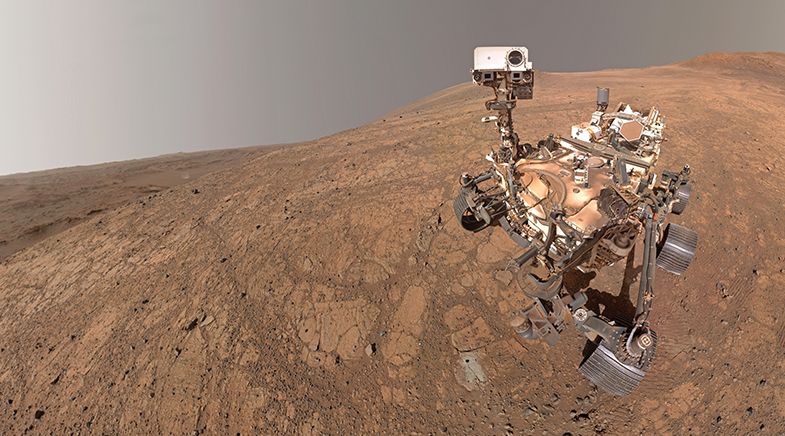
This is why research teams want to understand and classify the microbes found in the Puga area. Researchers are also examining the geology, minerals, and interactions between geology and microbiology in the region. In a previous Mars expedition, a rover called Spirit searched for signs of life on the Columbia Hills on Mars, which some astrobiologists believe was a site for an ancient hot spring (bit.ly/Rover-Spirit).
Hurowitz says that if the recently discovered biosignatures were created by microbial life, then it was by a microbe that was non-photosynthetic (living in mud) and dependent on specific sets of chemical reactions (iron and sulphate reduction) to fuel its metabolism. "We knew there were some potentially interesting rocks in the Neretva Vallis Channel [the ancient river channel that fed the Jezero Crater], but we had no reason to suspect that they might contain potential biosignatures," he says.
The rover's search for biosignatures on the terrain outside the Jezero Crater continues. "Our eyes are always open, looking for additional features like those (or maybe unlike those!) we saw in Neretva Vallis," he adds.
Have a
story idea?
Tell us.
Do you have a recent research paper or an idea for a science/technology-themed article that you'd like to tell us about?
GET IN TOUCH
